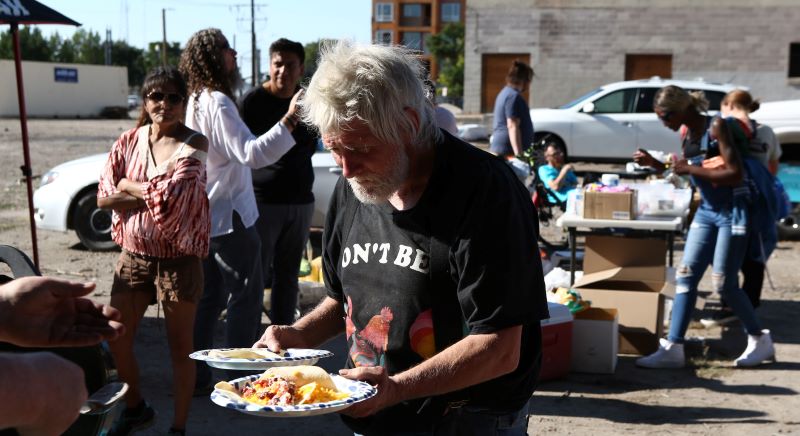We Are Humans, Plead Salt Lake’s Homeless Population
New York Times photographer says Salt Lake City’s ongoing efforts to clear out homeless people are inhumane and unnecessary.
Five years ago, the New York Times sent journalists to Salt Lake City to report on the deteriorating homeless situation and particularly on Operation Rio Grande. Robin Pendergrast was sent on assignment and he landed in Salt Lake to photograph the City’s efforts to contain and rehabilitate one of the fastest-growing segments of our population: the unsheltered homeless.
What began as a four–day photoshoot has now become a five-year stay in Salt Lake City. Pendergrast says, “ I kind of got hooked on the situation, and even then how mismanaged it was, how poor the response was to the homeless people.”
Since then Pendergrast has personally witnessed what he describes as the inhumane treatment of those who are so unfortunate to find themselves living on the streets. Further, the absence of compassion by city leaders toward assisting especially those who cannot, or will not stay in the shelters. The worst of the treatment Pendergrast says are the police and Health Department “abatements”.

Abatements are essentially homeless camp clean-outs. The Health Department and the police are involved in the abatements due to the unhealthy sanitation at the camps as well as the drug trade and drug use frequently occurring.
Pendergrast says that these abatements are completely inhuman harassment of people who are simply seeking security for themselves and loved ones. Pendergrast says that if basic sanitation services such as dumpsters and porta-potties were offered along with water, the unsheltered individuals living there could have a much better chance of getting back on their feet, getting jobs, finding housing, and a much greater degree of health and safety.
Utah Stories attended one such abatement in mid July. Stacy Johnson, who was camping at the site and who has become a spokesperson for the unsheltered community says that she is choosing to stay in camps, rather than the shelters because she refuses to break up her small family consisting of her husband and her dog. Currently, the shelters are full, but Johnson says she wouldn’t stay in a resource center even if there were space available.
Johnson pointed to scars on her face when she described to Utah Stories how a mentally ill woman severely bit her face while she was at the Gerald E. King Woman’s Shelter. Johnson and approximately forty other people were staying at the homeless camp on Union Pacific property located at 700 West 300 South from May to July. The site consisted of an assortment of RVs and tents, and garbage was piling up. Pendergrast was working to address the problem by arranging for a dumpster to be installed, but he found it was too late.
When the homeless campers were given notice, that yet again, the Salt Lake County Health Department would be conducting an abatement of the area, most fled the day before, but many were scrambling to collect all of their possessions while all of the remaining belongings and trash were scooped up by front-end loaders. We described this even in greater detail in a previous story.

Pendergrast says this ongoing practice is, “Completely inhuman.” Beyond taking photos Pendergrast is now personally delivering several dozen cases of bottled water each weekend to homeless camps. Providing what he says the city and the police will not provide: basic humanitarian aid to the homeless community in Salt Lake City.
Pendergrast says that he has personally witnessed the death of an elderly homeless man, who at the age of 65 succumbed to the heat. Pendergrast had delivered water to him in the evening where he was camping near Trader Joe’s on 400 South, but despite that “Joe was dead the next morning.”, he tells us.
Pendergrast mentions that he took a photo back in January when one of the largest and longest-lasting camps was getting abated, a place called Fort Pioneer, which resided under the freeway.
A brigade of front-end loaders, dump trucks, and police moved in to destroy the camp, which had lasted most of the winter undisturbed. By then the camp had become a home for about 140 individuals. A few homeless people had made a sign reading “We are human.”
“That sign and that message became emblematic of the situation here.” Pendergrast added, “It was our own Tiananmen Square right here in Salt Lake City.” The leaders of Salt Lake City are not recognizing that homeless people are indeed human and they deserve to be treated as such.
A Message to Salt Lake City Mayor Erin Mendenhall
On the Utah Stories Show, we offered Pendergrast to pass a message along to Mayor Erin Mendenhall. He said, “Please stop this. There is a better way. We can offer a much better short-term solution. Let these people have the basic necessities that they require by allowing a camp to exist.” Pendergrast is convinced that all that would be required is an empty lot with a dumpster; sanitation (Porta-potties) and water. He pleads to the Mayor, “Please treat these people with a little dignity. They are humans, and they need our help.”

Pendergrast says that if such a camp were allowed to exist, homeless support groups such as the Nomad Alliance would step up and provide much of the support that this population requires. The Nomad Alliance has provided 50 supply drops to homeless encampments in the past two years. This organization offers regular supply drops; the last one was August 8th, at 600 West 300 South.
WATCH THE INTERVIEW WITH ROBIN PENDERGRAST
RELATED CONTENT
The Other Side Academy in Salt Lake City Reforms Criminals, Convicts, Drug Addicts and Alcoholics
Why “Deeply Affordable” Housing Is Not Being Built in Utah and it Won’t be Built Anytime Soon
SUPPORT LOCAL JOURNALISM AND SUBSCRIBE TO PRINT MAGAZINE
Subscribe to Utah Stories weekly newsletter and get our stories directly to your inbox






